Trees of the Northern Forest
Trail Walk
28 July 2012
 Map of Adirondack Trees along the Barnum Brook Trail.
Map of Adirondack Trees along the Barnum Brook Trail.Click on the name of the plant for a description.
Trees of the Adirondacks
On 28 July 2012, VIC Naturalist Diane Minutilli led a nature walk focusing on trees of the Adirondacks. The walk covered the Barnum Brook Trail, focusing on the 11 species of trees and one shrub provided with identification tags along the trail.
The Adirondack Park was formed in response to concerns about trees. Settlers began harvesting Adirondack forests before the Revolutionary War. After the war, logging escalated, as the new government sold acreage to lumbermen to discharge war debts. The resulting depletion of watershed woodlands reduced the soil’s ability to hold water, hastening topsoil erosion and exaggerating periods of flooding. In response, the New York State legislature in 1885 established a Forest Preserve, stating that the Preserve "shall be forever kept as wild forest lands." The Adirondack Park was created in 1892; and a new covenant was added to the Constitution in 1895 to provide more meaningful protection of the Forest Preserve.
Most of the forest lands in the Adirondacks have been logged, burned over, or blown over. As a result, there is very little old growth forest in the Adirondack Park and no old growth forest on the VIC property. The nearly 3,000 acres of VIC property have all been logged; and some of this acreage shows the effects of blow-down.
Sugar Maple
Acer saccharum
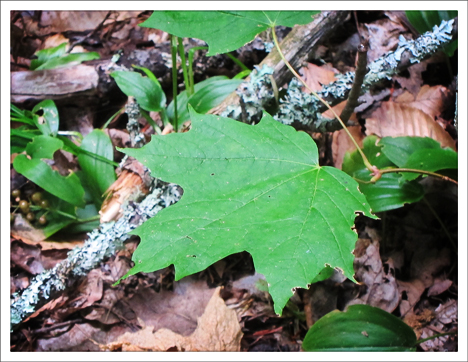 Trees of the Adirondacks : Sugar Maple on the Barnum Brook Trail
Trees of the Adirondacks : Sugar Maple on the Barnum Brook Trail
Sugar Maple is the state tree of New York. This deciduous tree grows 50-70 feet tall, with a single trunk. It has a life span of 200-300 years. The yellowish green leaves, which turn orange or red in the autumn, have five lobes and pointed tips. The edges of the leaves are smooth, not saw-toothed.
 The bark is gray, smooth when young and scaly when the tree gets older. The seeds are the familiar “helicopters.” The seeds are green, turning reddish tan; the seeds drop in late summer. Sugar Maples are the source of maple syrup and maple sugar. The hard wood of the Sugar Maple is used in furniture, flooring, and cabinets. The wood is especially suited for bowling alleys. The tree grows in rich, moist soils.
The bark is gray, smooth when young and scaly when the tree gets older. The seeds are the familiar “helicopters.” The seeds are green, turning reddish tan; the seeds drop in late summer. Sugar Maples are the source of maple syrup and maple sugar. The hard wood of the Sugar Maple is used in furniture, flooring, and cabinets. The wood is especially suited for bowling alleys. The tree grows in rich, moist soils.
Sugar Maples have been affected by climate change. The tree does not like the warmer temperatures and has already started to disappear in central and southern New York State.
American Beech
Fagus grandifolia
 Trees of the Adirondacks : American Beech on the Barnum Brook Trail
Trees of the Adirondacks : American Beech on the Barnum Brook Trail
American Beech is a medium to large deciduous tree, with a short, thick single trunk. The leaves are egg-shaped, with parallel veins ending in a tooth. Each leaf has a long pointed tip. The leaves turn brown in fall, but (unlike most deciduous trees) remain attached until nearly the end of winter. The fruits of the tree are small, triangular nuts, surrounded by a bur. The buds are long, sharp, and pointed.
 The light blue-gray bark is unusual, since it remains smooth even as the tree ages. The dried leaves (softer than straw) from this tree were once used to stuff mattresses. The wood of the American Beech is used in both furniture and flooring. The tree has important benefits to wildlife, since a variety of animals (including squirrels, bear, raccoons and deer) eat the edible beechnuts. This tree is a climax tree and can tolerate shade.
The light blue-gray bark is unusual, since it remains smooth even as the tree ages. The dried leaves (softer than straw) from this tree were once used to stuff mattresses. The wood of the American Beech is used in both furniture and flooring. The tree has important benefits to wildlife, since a variety of animals (including squirrels, bear, raccoons and deer) eat the edible beechnuts. This tree is a climax tree and can tolerate shade.
Bigtooth Aspen
Populus grandidentata
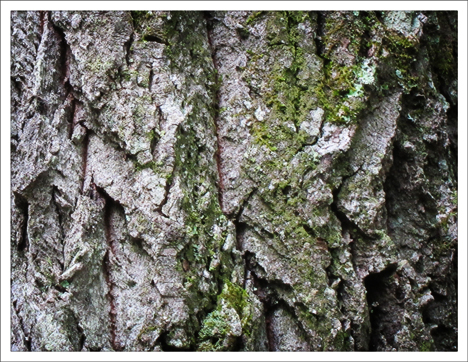 Trees of the Adirondacks : Bigtooth Aspen on the Barnum Brook Trail
Trees of the Adirondacks : Bigtooth Aspen on the Barnum Brook Trail
Bigtooth Aspen is a deciduous tree, one of over forty species of poplar found in the northern hemisphere. It is relatively short-lived, with a life span of up to 100 years. Its name is derived from the large teeth on the oval leaves, which turn yellow in the fall. The bark of the Bigtooth Aspen is olive green, smooth when young, turning dark brown and deeply furrowed with age. The leaf stalk is flattened. The large leaves of the Bigtooth Aspen catch the slightest breeze, casing them to rustle and tremble in the wind. The soft, inner bark makes this tree the beaver’s preferred food. This tree is often a “pioneer” after a fire or logging activity clears the forest.
Striped Maple
Acer pensylvanicum
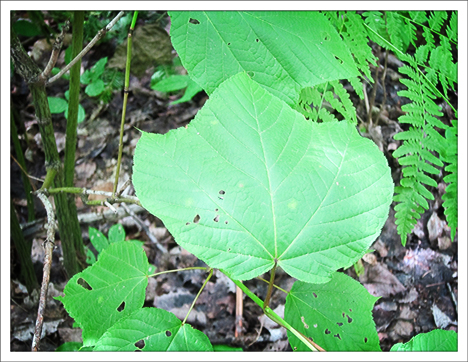 Trees of the Adirondacks : Striped Maple on the Barnum Brook Trail
Trees of the Adirondacks : Striped Maple on the Barnum Brook Trail
Striped Maple is a deciduous tree which grows in the Adirondacks. The flowers of this tree bloom in late May and early June. The fruit is a pair of winged keys attached by thin stalks, hanging in clusters. Striped Maple is an understory tree, growing about 10 to 30 feet tall in the shade of larger trees.
 The bark of the Striped Maple (as implied by the name) is distinctly striped, making it easy to identify, even in winter. The leaves, which are often very large, have three lobes and are shaped like a goose foot. They turn yellow in the fall. White-tailed deer browse on the leaves during spring and summer, and also eat the twigs and saplings in the winter. Before nails, the wood of the Striped Maple was used for pegs in construction.
The bark of the Striped Maple (as implied by the name) is distinctly striped, making it easy to identify, even in winter. The leaves, which are often very large, have three lobes and are shaped like a goose foot. They turn yellow in the fall. White-tailed deer browse on the leaves during spring and summer, and also eat the twigs and saplings in the winter. Before nails, the wood of the Striped Maple was used for pegs in construction.
Red Spruce
Picea rubens
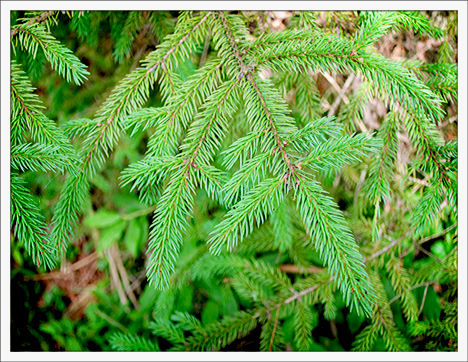 Trees of the Adirondacks : Red Spruce on the Barnum Brook Trail
Trees of the Adirondacks : Red Spruce on the Barnum Brook Trail
The Red Spruce is a conifer and a member of the Pine family. It is a medium-sized tree, growing 50 to 70 feet tall with a single straight trunk. This tree is said to favor nutrient-poor soils and can thrive in deep shade.
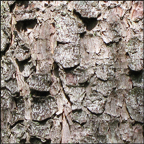 The bark of the Red Spruce is reddish brown, thin with many small scales. The single needles are stiff and sharp, ½ to ¾ inch long. The small (.75 to 1.5 inches long) cones are green or purplish, turning reddish brown at maturity. The fermented needles and twigs of the Red Spruce were once boiled with honey to make a beer. Gum was also made from the resin. The Red Spruce is one of the most important economic trees in the Adirondack Park. It is very strong structurally and has been used to build houses.
The bark of the Red Spruce is reddish brown, thin with many small scales. The single needles are stiff and sharp, ½ to ¾ inch long. The small (.75 to 1.5 inches long) cones are green or purplish, turning reddish brown at maturity. The fermented needles and twigs of the Red Spruce were once boiled with honey to make a beer. Gum was also made from the resin. The Red Spruce is one of the most important economic trees in the Adirondack Park. It is very strong structurally and has been used to build houses.
Eastern White Pine
Pinus strobus
 Trees of the Adirondacks : Eastern White Pine on the Barnum Brook Trail
Trees of the Adirondacks : Eastern White Pine on the Barnum Brook Trail
This large conifer is one of the signature trees of the Adirondacks. The Eastern White Pine is the largest eastern conifer, growing up to 125 feet tall, depending on the soil. Because the tree grows higher than surrounding trees, it is subject to wind damage and the branches on the part of the tree that faces the winds often fall off. This tree has clustered needles (five to a cluster). Each needle is three to five inches long and is soft and flexible. The long, thin needles seem to whisper in the breeze.
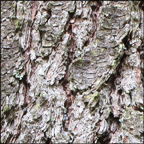 The bark is gray to brown and develops large broad scales as the tree ages. The cones are five inches long, with a pointed white tip. The long, straight trunks of the Eastern White Pine were used to make ship’s masts. This is one of the most important timber trees in the Northeast. This plant reportedly was employed medicinally by several native North American Indian tribes as an antiseptic. Pitch can also be obtained from the resin and reportedly has been used for waterproofing canoes and as a wood preservative.
The bark is gray to brown and develops large broad scales as the tree ages. The cones are five inches long, with a pointed white tip. The long, straight trunks of the Eastern White Pine were used to make ship’s masts. This is one of the most important timber trees in the Northeast. This plant reportedly was employed medicinally by several native North American Indian tribes as an antiseptic. Pitch can also be obtained from the resin and reportedly has been used for waterproofing canoes and as a wood preservative.
Red Maple
Acer Rubrum
 Trees of the Adirondacks : Red Maple on the Barnum Brook Trail
Trees of the Adirondacks : Red Maple on the Barnum Brook Trail
This deciduous Adirondack tree is known for its brilliant (usually bright red) fall foliage. It grows 40 to 60 feet tall, with a single trunk and a narrow, dense crown. The light green leaf of the Red Maple is lobed, with shallow notches between the lobes. The leaf, in contrast to that of the Sugar Maple, is saw-toothed. The leaves are smaller than those of the Sugar Maple and turn red to orange in autumn. The leaf stalk is red. The bark is smooth and gray when young, becoming scaly and darker with age. The seeds are small “helicopters” which drop in early June. The Red Maple prefers wet to moist soils and can often be seen growing along swamps or depressions that hold water. It has the greatest north-south distribution of all trees found along the East coast.
Balsam Fir
Abies balsamea
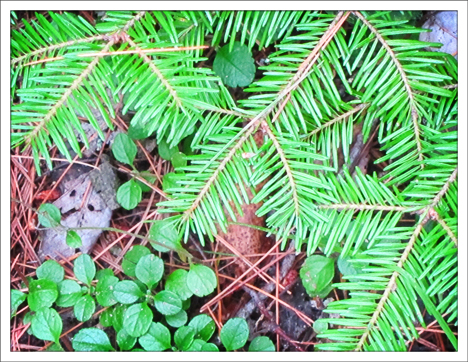 Trees of the Adirondacks : Balsam Fir on the Barnum Brook Trail
Trees of the Adirondacks : Balsam Fir on the Barnum Brook Trail
This Adirondack conifer is a member of the Pine family. It grows 50-75 feet tall in a tapering spire, with many horizontal branches from the ground up. The needles of the Balsam Fir are attached singly, with no stalks and rounded ends. The needles are shiny green above, with two silvery lengthwise lines or groves below. The bark is smooth with resin blisters. The cones, which are purple to green, grow upright in dense clusters near the top of the tree and are a favorite food of squirrels. This tree is well-known for its fragrant needles and is a popular Christmas tree because it holds its needles well after cutting. Resin from the trunk of the Balsam Fir was once used for making varnishes and sealing birch bark canoes. It has also been used for mounting microscope specimens and as optical cement. This tree is also called Canada Balsam or Eastern Fir.
Paper Birch
Betula papyrifera
 Trees of the Adirondacks : Paper Birch on the Barnum Brook Trail
Trees of the Adirondacks : Paper Birch on the Barnum Brook Trail
A deciduous tree, the Paper Birch has chalky white, smooth bark with dark horizontal lines; the bark often peels in papery strips on older trees. The inner bark is a reddish color. The leaves, which are oval to triangular, with pointed tips and double-toothed edges, are dull green above and pale green on the underside. They turn yellow in the fall. Paper Birches often grow in clumps of two or more trees. The wood of the Paper Birch makes excellent firewood, burning hot and fast; and the bark is often used to start fires. This understory tree likes moist soil. This tree is also called the White Birch or Canoe Birch, the latter name is a reference to the fact that native Americans used it to construct canoes, baskets, and water containers. This tree is often found in large stands after forest fires burn an area. The tree has a relatively short life span, living from 80 to 100 years.
Eastern Hemlock
Tsuga canadensis
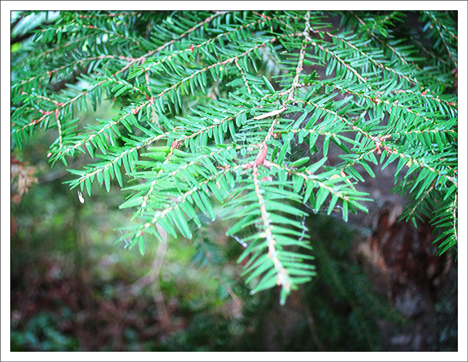 Trees of the Adirondacks : Eastern Hemlock on the Barnum Brook Trail
Trees of the Adirondacks : Eastern Hemlock on the Barnum Brook Trail
The Eastern Hemlock is a very long-lived tree, with a life span of 600 years or more. This tree is also called the Canada Hemlock or Hemlock Spruce. The Eastern Hemlock is often found with Yellow Birch in cool rocky valleys and ravines.
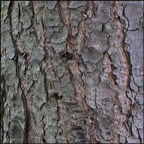 A member of the Pine family, this Adirondack conifer has short single needles arranged in two rows. The small cones are green, turning brown in maturity; they hang like tiny pendants. The bark is dark brown and deeply grooved; fresh cut bark shows purple streaks. The small holes in the trunk reflect the work of Yellow-bellied Sapsuckers. Eastern Hemlocks like wet soils and are shade tolerant. The pitch knots are so hard they can chip saw blades. Native Americans and woodsmen once made tea from the needles and twigs.
A member of the Pine family, this Adirondack conifer has short single needles arranged in two rows. The small cones are green, turning brown in maturity; they hang like tiny pendants. The bark is dark brown and deeply grooved; fresh cut bark shows purple streaks. The small holes in the trunk reflect the work of Yellow-bellied Sapsuckers. Eastern Hemlocks like wet soils and are shade tolerant. The pitch knots are so hard they can chip saw blades. Native Americans and woodsmen once made tea from the needles and twigs.
Hobblebush
Viburnum alnifolium
 Adirondack Shrubs : Hobblebush (Witch Hobble) on the Barnum Brook Trail
Adirondack Shrubs : Hobblebush (Witch Hobble) on the Barnum Brook Trail
Hobblebush, also called Witch Hobble, is a woodland shrub common throughout the Adirondacks and the VIC property. The shrub, a member of the Viburnum genus, has pendulous branches that take root where they touch the ground, forming obstacles that trip (or hobble) passers-by – giving the plant its common name. Hobblebush has large heart-shaped, light green leaves, which were once used by woodsmen as an early form of toilet paper. This plant blooms in May in flat-topped clusters of small white flowers. The flowers are followed by fruit which is scarlet when young and blue-black when ripe. The fruit is said to be edible. The fall foliage is usually a deep wine red.
Yellow Birch
Betula lutea
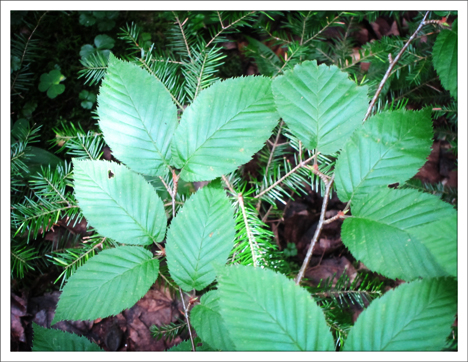 Trees of the Adirondacks : Yellow Birch on the Barnum Brook Trail
Trees of the Adirondacks : Yellow Birch on the Barnum Brook Trail
This deciduous Adirondack tree grows up to 70 feet tall, with a single trunk and round irregular crown. In contrast to the white bark of the Paper Birch, the bark of the Yellow Birch is shiny yellow to bronze and peels in very thin curls.
 The bark becomes coarse and scaly with age. The leaves are oblong, long and pointed and saw toothed. Broken twigs of the Yellow Birch have a distinct wintergreen smell. The tender twigs reportedly can be used to make a pleasant-tasking tea. The wood of this tree is used to make furniture and veneers. The seedlings are a favorite food of the White-tailed Deer.
The bark becomes coarse and scaly with age. The leaves are oblong, long and pointed and saw toothed. Broken twigs of the Yellow Birch have a distinct wintergreen smell. The tender twigs reportedly can be used to make a pleasant-tasking tea. The wood of this tree is used to make furniture and veneers. The seedlings are a favorite food of the White-tailed Deer.
Additional Sources of Information on Adirondack Trees
- Barnum Brook Tree Game. Paul Smith’s College VIC.
- Plants for a Future. Data Base.
- United States Department of Agriculture. Natural Resources Conservation Service. Data Base.
- United States Department of Agriculture. Silvics of North America. Volumes 1 and 2.
- Lady Bird Johnson Wildflower Center. Native Plant Information Network.
- Flora of North America. Data Base.
- ENature Field Guide. Trees.
- Stan Tehiela. Trees of New York. Field Guide (Adventure Publications, Inc., 2006).
- William K. Chapman and Alan E. Bessette. Trees and Shrubs of the Adirondacks. A Field Guide (North Country Books, 1990).
- Peterson Field Guides. Eastern Forests (Houghton Mifflin, 1988,1998).
Trees of the Adirondacks
